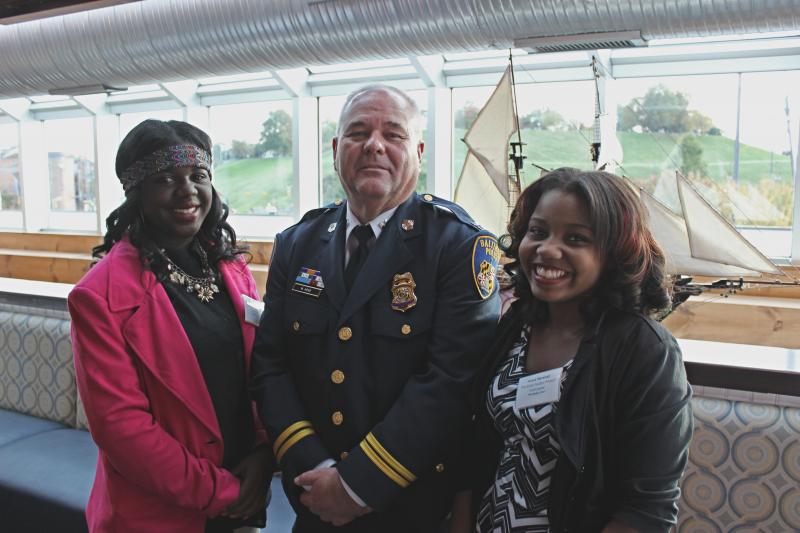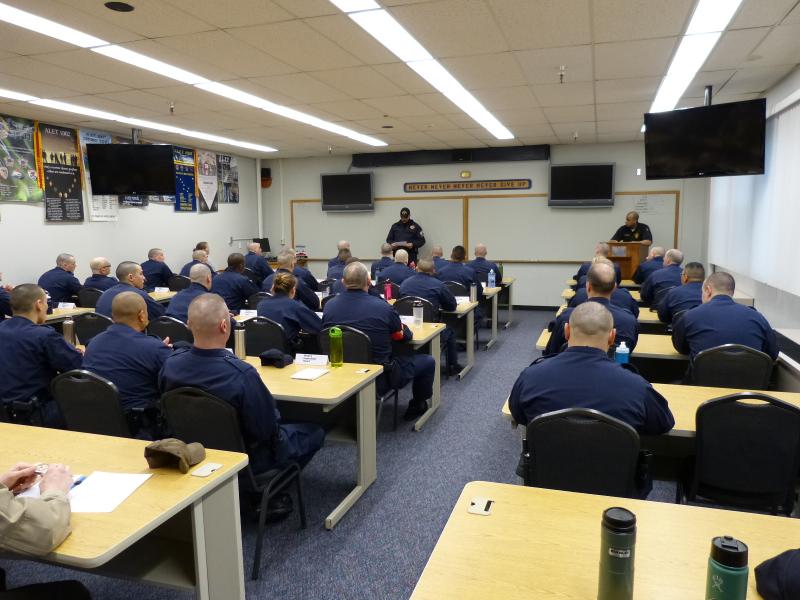Respect
A year after the events in Ferguson, Mo., split the nation with fault lines of confusion, anger and mistrust, grave issues still exist with the way police and their communities interact.
The arrest and subsequent death of Sandra Bland caused an outcry. The shooting of Walter Scott outraged the nation. The death of Freddie Gray set Baltimore on fire. High profile cases of alleged police misconduct are causing many Americans – minorities in particular – to view police with resentment and fear.
But in an age where everyone’s carrying a camera and the Internet gives anyone a platform to sound off, police officers are often caught in the crossfire of misplaced rage and ignorance. All too frequently officers are showing up in news feeds “behaving badly” in 30-second video clips without much context to understand the events transpiring.
Regardless of justification, the atmosphere for police in America is growing increasingly hostile, so how are local police forces combating the negativity in the press and in their communities?
The power of connection
Chris Cognac, sergeant of the Community Affairs Unit with the Hawthorne, Calif., Police Department, thinks the tides of public opinion can shift one conversation – and one cup of coffee – at a time.
In 2011, the Hawthorn Police Department was looking for a way to improve its community relations. “We needed to do something different to try and reach out and connect with our community,” Cognac says. “We wanted to do something that was simple and obviously cost-effective.”
One of the problems Hawthorne was facing, according to Cognac, is that the publicized actions of officers, regardless of location, impacts the institution of policing overall. Simply put, if an officer in Alabama is found guilty of misconduct, that affects how the public perceives officers in California.
 However, Cognac wondered if the trend could work both ways. If negative public perception was without borders, could positive perception of the police spread as easily?
However, Cognac wondered if the trend could work both ways. If negative public perception was without borders, could positive perception of the police spread as easily?
Though departmental brainstorming, the idea for “Coffee with a Cop” was conceived. As the name implies, the program encourages residents to visit local coffee shops and have informal, low-pressure discussions with law enforcement officers over a cup of Joe.
The idea spread through the industry press and word of mouth – first to Superior, Wis., and Gulf Shores, Ala. – both of which saw successes through their respective programs. Cognac says that as the ball began to roll, the University of Illinois contacted Hawthorne with the idea to write a grant proposal to help the program grow.
Through its partnership with the university, the Hawthorne PD received a U.S. Department of Justice (USDOJ) Office of Community Policing grant, which awarded the Coffee with a Cop program $399,990 to develop an official curriculum and infrastructure, as well as to fund 10 regional training sessions across the U.S.
During the training sessions, the Coffee with a Cop team worked with officers from across the country to develop communications skills, overcome cultural boundaries and engage in procedural justice, Cognac says, but it mainly focused on how to speak with members of their community. “A lot of it was how to talk to people,” he says, “how to not be that unapproachable cop.”
The program’s strength, Cognac says, is derived from its informal nature. “[There are] no speeches, no agendas,” Cognac says. “This isn’t a meeting.”
Events are held in local establishments where officers get to know community members, whether residents showed up for the session or simply to grab a coffee before work.
“That’s the best part,” Cognac says, “because you’re getting to know people who weren’t there to necessarily see you, so you’re making that face to face, barrier-free interaction.”
Another element that makes the program so successful is that it involves everyday officers. “That’s what’s so great about this,” Cognac says. “It’s about the police officers that actually serve. It’s not about the figurehead or the brass.” At its core, the program is about connecting the officers to the people they serve and protect on a daily basis in a meaningful way.
In his experience, Cognac says the topics discussed at a typical event cover a broad range. Often it’s an individual that just wants to meet a police officer. Sometimes it’s a resident that wants to thank them for their service. Sometimes it’s a person who has a significant complaint, or someone who wants to bring a non-emergency to the department’s attention. All conversations are treated with respect and handled accordingly.
The obvious benefit of the program, Cognac says, is the increase in trust residents feel for their police, but the program has had the unintentional benefit of increasing officer morale. Often officers only see the worst in a community. By interacting with community members positively, jaded officers can gain a new perspective. “It works both ways,” Cognac says.
However, as simple as the program sounds, “there are a million ways to screw it up,” Cognac says, laughing. “Don’t park too many cop cars out front, or it looks like a crime scene.”
But more seriously, he says it’s important to understand the program shouldn’t be run as a question and answer session, or it quickly loses appeal. The point, Cognac says, is for regular people to have access to a police officer for 10 or 15 minutes, have a conversation and then leave – not wait through a town-hall type discussion to be heard. “This is intimate and barrier-free,” he says.
Another way to remove barriers is to hold sessions where people already are, such as a Starbucks or local diner. “Coffee with a Cop is always held at a neutral location,” Cognac says. “You cannot hold it in a government building; you cannot hold it in a police station.”
The program has spread “like wildfire,” according to Cognac. It’s in well over 1,000 municipalities and counties across 48 states (Hawaii and Connecticut are the only stragglers) and has spread internationally to Canada, Australia and several European countries.
“It’s just been a gigantic force to grow community policing and grow community trust with the police on a global basis,” Cognac says. “I really think it’s the most successful community policing program in the world – because it’s simple, it doesn’t cost anything and it works.”
Editor’s Note: Cognac says Coffee with a Cop training sessions are offered at no cost. Agencies only have to provide plane tickets and hotel rooms for trainers. For more information, visit www.coffeewithacop.com.
It’s clear that engaging with the community is an important element in reshaping public perception, but one organization in the troubled city of Baltimore is taking that engagement one step further – using those who feel marginalized by the police to offer police training.
The Power of Youth
Baltimore’s Inner Harbor Project has been running for four years, with the mission of empowering young people to use research to develop solutions for the issues that divide their society by race, class and culture. Geographically, the project focuses on the city’s main public space from which it gets its name.
“I believe public spaces present this really interesting opportunity for people that don’t usually come together to exist in the same space, and to care about it,” says Celia Neustadt, founder and executive director of the project. The Inner Harbor, much like the French Quarter in New Orleans or Millennium Park in Chicago, serves both as an economic center for the city, attracting the wealthy and successful, as well as a gathering place for the poor, disenfranchised and the young. These cultural differences, she says, often lead to conflict – conflict the city’s police force must deal with.
The Inner Harbor Project employs 25 rigorously vetted youth leaders, aged 14 to 18, who aren’t particularly academically engaged, but are tremendously socially involved. “They are the leaders among their peers,” Neustadt says. “They are change leaders.”
The organization spent two years researching the city’s socioeconomic landscape and ultimately developed five programs to help create a more harmonious Baltimore. One element is the project’s youth engagement training.
 There is a tremendous amount of tension, Neustadt says, between the city’s youth and authority figures, but the city’s police officers were confused as how to best approach the problem. “We heard from all of the police officers and security personnel that we interviewed that they really feel unprepared to interact with youth,” Neustadt says. The youth engagement training program aims to solve this issue by training officers in how to best interact with youths, and the program is exclusively led by the young people who are representative of those the officers would be interacting with.
There is a tremendous amount of tension, Neustadt says, between the city’s youth and authority figures, but the city’s police officers were confused as how to best approach the problem. “We heard from all of the police officers and security personnel that we interviewed that they really feel unprepared to interact with youth,” Neustadt says. The youth engagement training program aims to solve this issue by training officers in how to best interact with youths, and the program is exclusively led by the young people who are representative of those the officers would be interacting with.
“We spent a year designing and piloting the training,” Neustadt says, and ultimately it was decided that the main goal of the training should not only be to instill empathy for youth in the officers, but also vice-versa. “So the training is a little bit more like a workshop,” she says. “It’s scenario-based.”
Executive Leader of the Police Training Team, 18-year-old Adrian Hughes, says the sessions are broken up into three one-hour blocks. The first focuses on communication techniques, making a positive first contact and how to prevent problems from occurring before they start. The second session, Hughes says, is based on empathy and helps officers remember the struggles of being a teenager. The third session brings the first two together in situational exercises.
All of the sessions are run conversationally. “The police officers spend a lot of time talking about where they are coming from,” Neustadt says, “and the youth leaders spend a lot of time listening. It’s really an exchange to instill empathy and respect.”
The program was piloted successfully in November 2014 with a private security force and has since been used to train two police units who patrol the Inner Harbor and surrounding neighborhoods. In all, 23 police officers were trained.
The project also hosted a training session at the police academy for incoming cadets, which Neustadt says was particularly special. Many of the cadets were not from Baltimore, and the training session was the first time they interacted with young people from the inner city.
This academy training session also was extremely helpful, Neustadt says. The cadets were asked to complete an exit survey, where 100 percent of the respondents indicated the training had a great impact on how they will interact with youth in the future. One officer expressed “I think the class was a great way for us to understand how to talk to teens and youth in a positive way.” Another noted, “This is a great concept of training and I hope that this program can grow,” according to program materials.
The program is also seeing success on the street level. Hughes cites an example of a recent interaction one of his team members witnessed between two trained officers and a youth who was creating a disturbance. “They approached [the teen] as a person… had conversation with him to see where he was coming from, and directed him to programs to get him the help he needed,” Hughes says. Prior to their training, these officers may have approached the situation aggressively, and the result could have been far more negative.
Neustadt says the ultimate goal of the Inner Harbor Project isn’t to cure all of the country’s ills, or even to create systemic change in the way policing is performed. It is to reach both officers and young people on a personal level to create compassion, trust and understanding. There are myriad problems between the disenfranchised and those in authority, but “I think the way to break that down is through individual connections,” Neustadt says. “The power of individual connection – it’s big.”
The Power of Language
Lt. Chad Goeden feels that to shift the public’s perception of the police, an important linguistic change must be made in the way they are trained.
Goeden is a 19-year veteran of the Alaska State Police, and has worked beats from rural outposts to major metropolises. He currently serves as the commander of the Alaska Department of Public Safety Training Academy, where he is in charge of training state troopers, municipal officers, park rangers and other public safety officials. “We cover the broad spectrum of training,” he says, “We don’t just train state troopers here.”
But Goeden’s training differs in a slight yet important way from many programs across the country. He does not allow trainees to be referred to as “warriors.”
“What message are we sending, what goal are we trying to accomplish by calling them warriors?” Goeden asks. “Because if they are indeed warriors, that begs the question, who are we at war with? We can’t go to war with our own citizens.”
 Goeden instead prefers the term “guardian” when referring to trainees. A warrior, he says, trains to battle against an enemy, and to vanquish them at all costs. A guardian, he says, trains to protect the rights and property of individuals.
Goeden instead prefers the term “guardian” when referring to trainees. A warrior, he says, trains to battle against an enemy, and to vanquish them at all costs. A guardian, he says, trains to protect the rights and property of individuals.
Historically, the shift in America from guardian to warrior, Goeden says, occurred gradually and with good reason. In the 70s, 80s and 90s, he says, too many officers were being killed in the line of duty. Policing was a very dangerous job during that time, and to keep officers safe, they were encouraged to use whatever force was necessary. The first priority during that time became officer safety, and a rise in militarization and aggressive tactics accomplished that goal.
Officer safety is, of course, still one of the highest priorities, Goeden says. He says the problem is that too many training academies stop there without understanding the implications that type of training creates.
“Really, the highest priority can’t be officer safety,” Goeden says. “It needs to be very near the top, and we need to do things in a safe, calculated manner, and we need to be able to use force to protect ourselves… but it can’t be, from the point of view of the police officer, the most important thing. Otherwise we’d stay home.”
It’s possible the “fight for your life” attitude has outlived its usefulness. In 2013, 27 police officers were feloniously killed, the lowest number in more than 50 years, according to FBI statistics. In fact, the number of officers killed on duty has consistently declined since the mid-90s, and is consistent with the overall drop in violent crime in the country. Assaults against officers are also on the decline.
However, that isn’t to suggest policing isn’t dangerous, and this doesn’t mean the warrior mentality should be done away with. Goeden says that the country certainly needs courageous officers willing to run towards the sound of gunfire – that takes some warrior spirit – but the problems, he feels, occur when every interaction is colored by this mindset.
“Here’s the thing that I think gets missed,” Goeden says. “I do not believe it’s an either/or. I don’t think that either you’re a warrior or a guardian. I think being a guardian means being more than a warrior.”
Shifting mindsets from warrior to guardian won’t mean a decline in awareness or even necessarily the force applied, Goeden says. He uses the analogy of a mother bear protecting her cubs. The bear is hyper-vigilant and will protect her cubs violently if necessary, but she’s acting as a guardian, not a warrior. “[Being] a guardian doesn’t necessarily change the amount of force we use or how we use force,” he says, “it changes the mindset we approach situations with.”
Goeden admits that to experienced officers who are already doing their jobs well, the distinction won’t matter much. These officers already have a guardian mentality perhaps without even realizing it. Where the distinction becomes important, he says, is in the minds of the next generation of officers who need to have a correct understanding of their role to do an extremely difficult job in the best way possible.
_____________
To get connected and stay up-to-date with similar content from American City & County:
Like us on Facebook
Follow us on Twitter
Watch us on Youtube




















